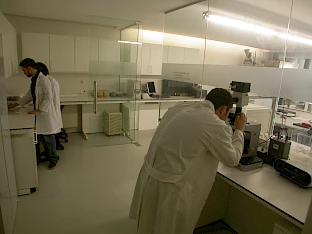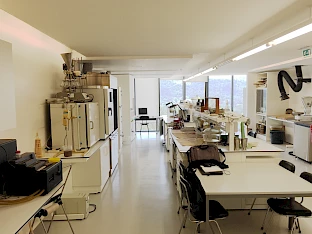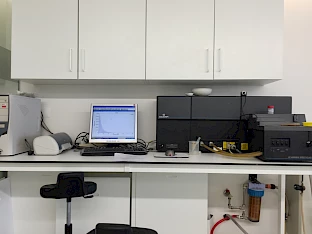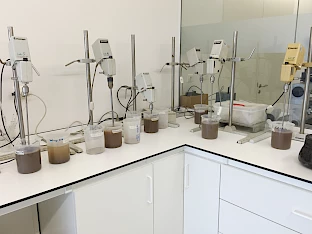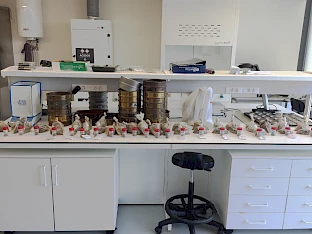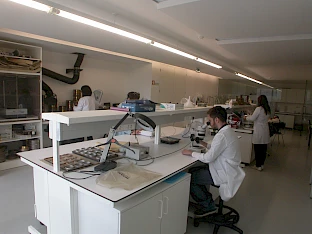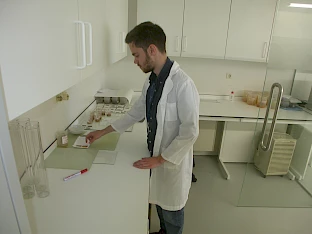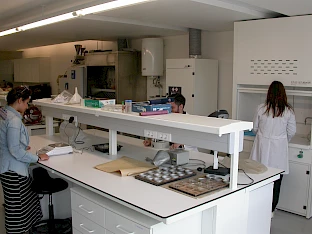Sedimentology Laboratory Regulations
Laboratory use form
Registration in the team of collaborators for laboratory activities
(only in Portuguese)
Services
- Provision of specialized services to the community, namely to companies, other State institutions and external research projects. For more information click here.
Activities
- Support for academic research work.
- Space for the development of teaching/learning activities within the scope of practical or theoretical-practical work in undergraduate, master's and doctoral courses at Univ. Coimbra.
- Space for the development of research activities within the scope of the Master's in Geosciences and Doctorate in Geology at UC (thesis elaboration).
- Collaboration in activities for the dissemination of Geosciences (visits by students and teachers or exhibitors).
- Provision of specialized services to the community, namely to companies, other State institutions and external research projects.
Equipment
- Beckman-Coulter laser granulometer mod. LS230 (0.04 to 2000 µm) (year 2005), to carry out granulometric analyzes of sediments with granulometry <63µm;
- Sieve shaker brand Retch mod. AS200 control G (year 2005), for carrying out granulometric analysis of sand (>63 µm);
- Binocular magnifier 50x brand Wild mod. Heerbrugg 84220;
- Leica EZ4 35x binocular loupes;
- Centrifuge brand Heareus Megafuge 16, to obtain suspensions with granulometry <2 µm necessary to obtain sedimented slides;
- Refrigerated Sorval RC-5B centrifuge, for washing sediment (removal of dissolved ions);
- Greenhouses up to 100.°C (Heareus brand), suspension stirrers, scales, etc.
Laboratory Tasks
- Preparation of samples for analysis;
- Screening at ½ Phi of unconsolidated or disaggregated sandy sediment;
- Laser granulometry (suspension preparation and analysis) of samples < 2000µm;
- Obtaining a sedimented slide with a fraction <2µm for further X-ray diffraction;
- Fraction separation > and < 63µm for composition identification by XRD;
- Determination of the % of water in sediment;
- Limestone or marl grinding (80 or 100 Mesh) for chemical analysis;
- Calcimetric analysis;
- Separation of heavy minerals and assembly of grain on slides or sample holders;
- Sample preparation for heavy mineral separation (6N HCl attack, washing, drying and sieving);
- Determination of the composition and morphoscopy of sands by observation with a binocular magnifying glass (up to 50x).
The University of Coimbra's Sedimentology Laboratory aims to carry out granulometric, compositional and morphoscopic analyzes of sedimentary rocks, within the scope of research, teaching or service activities abroad.
This laboratory structure has been operating at Univ for several decades. Coimbra. In 1949, the so-called “Sedimentation Laboratory” was installed by Prof. Gaspar Soares de Carvalho, including the characterization of sand grains by observation with a binocular magnifying glass, separation of heavy minerals and dimensional analysis of sediments (using a Rot-Tap sieve shaker and a set of Andersen pipettes). Around the year 1960, already with the designation of Laboratory of Sedimentology, Prof. António Ferreira Soares developed it with equipment and human resources. Since 2003, the Sedimentology Lab has been coordinated by Prof. Pedro Proenca Cunha.
Research activities have been carried out within research units recognized by the Foundation for Science and Technology (FCT), namely: for several decades, at the Geosciences Center of the Univ. Coimbra; since 2008, most of its researchers have been integrated into IMAR-CMA; and from 2015, at MARE - Marine and Environmental Sciences Centre. Laboratory investigators are members of the International Association of Sedimentologists.

